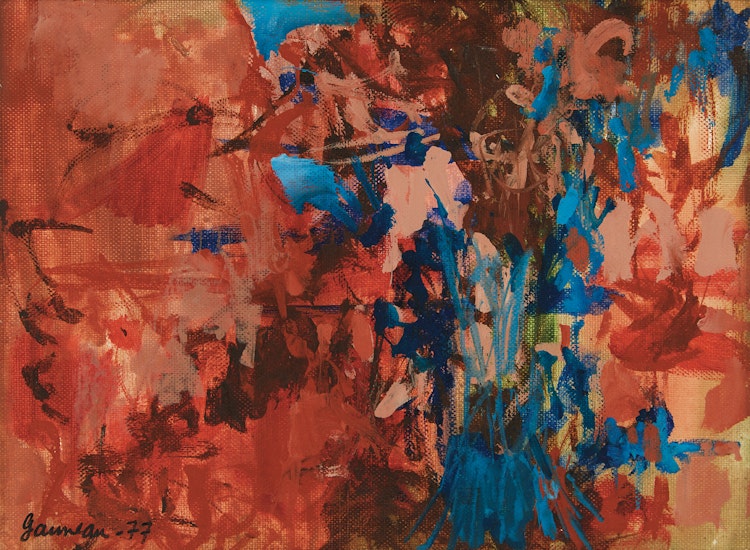Bleu de Rose by Pierre Gauvreau

Pierre Gauvreau
Bleu de Rose
acrylic on canvas, laid down on board
signed and dated 1977 lower left
9.25 x 12.25 ins ( 23.5 x 31.1 cms )
Auction Estimate: $3,000.00 - $4,000.00
Price Realized $3,795.00
Sale date: March 8th 2017
Lacerte Art Contemporain, Montreal
Private Collection, Toronto
Ray Ellenwood, “Egregore: A History of the Montreal Automatiste Movement,” Toronto, 1996, pages 14-20
Roald Nasgaard and Ray Ellenwood, “The Automatiste Revolution: Montreal, 1941-1960,” Toronto, 2009, pages 49-51
Experimentation with technique and style as a means of process and discovery was essential to Gauvreau’s practice. Taking a decade break away from painting to pursue television and film production, Gauvreau returned to painting in the mid 1970s and devoted the remainder of his career to painting.
“Bleu de Rose” is indicative of the artist’s ability to capture energy and spontaneity in the gestural brushstrokes influenced by calligraphy. Frantic movements of the brush are evident with the bright blue pigments left as traces of Gauvreau’s movement as he worked. The contrast between the earthy rose and vibrant blue tones create an energy radiating from the work, emphasized by the artist’s painterly technique.
Share this item with your friends
Pierre Gauvreau
(1922 - 2011) Les Automatistes
Pierre Gauvreau was born in Montreal in 1922. He entered the Ecole des beaux arts in 1939. His works immediately attracted the attention of the painter Paul-Emile Borduas, who invited him to join a group of intellectuals and artists who met in his studio. Gauvreau became a member of the Contemporary Art Society (formed in 1939) which included Borduas, John Lyman and others.
From 1943 to 1946, he served in the Canadian Army but continued to paint and show his works. Posted in England, he sent works to his brother Claude in April 1946 for l'exposition de la rue Amherst, a showing considered to be the premiere of the Automatistes group. Along with 15 other members of the group of intellectuals and artists he signed Refus global, a manifesto drawn up by Borduas in 1948. This manifesto which contested among others, Catholic values, unleashed a revolution of artistic creation in Canada.
Later Gauvreau struck out on his own after becoming dissatisfied with painting in general and he stopped exhibiting his work. He turned his attentions to radio, film-making, theatre, and he became a CBC-TV producer. In Weekend Magazine the following note appeared, “Gavreau doesn’t like to discuss his artistic philosophy” and it quoted him as saying, “I don’t like to intellectualize what I do . . . I find non-figurative painting more interesting because the other is ‘épuisé’ – worn out. This is the point we’ve reached in the history of painting. That’s all.”
About 1961 he started exhibiting his work again at the Delrue Gallery (later Galerie Libre) when his gouaches were on view. Dorothy Pfeiffer noted the following in 1962 “His graceful non-figurative forms blossom and flower in space with an almost tensile strength and delicacy. There is nothing of violence no confusion in Graveau’s work. Each single brush-stroke, every glowing dash of colour is both reasoned and refined. Many of his paintings appear to grow, or expand, outward ad upward from one central motif.”
Pierre Gauvreau received the Prix Louis-Philippe-Hebert in 1995 for his pictorial oeuvre. He died in Montreal on April 7, 2011.
Sources: "A Dictionary of Canadian Artists, Volume II”, compiled by Colin S. MacDonald, Canadian Paperbacks Publishing Ltd, Ottawa, 1979; www.canadianartgroup.com/Pierre_Gauvreau

